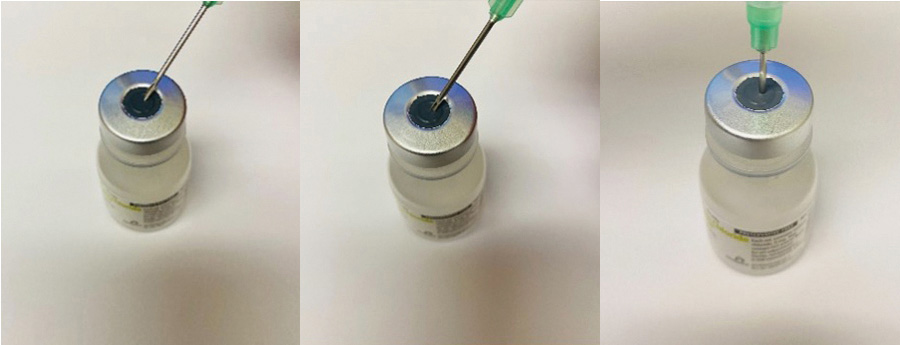Withdrawing medication from an injectable vial is something that many of us now do unconsciously. However, when teaching others or reviewing your technique, it is important to ensure that you are maintaining sterility and using appropriate methods.
You should always wipe the top of the vial with an alcohol swab, even after removing the dust cap, to avoid bacterial contamination. Studies have shown that under some storage conditions related to temperature, humidity, and airflow, bacteria and fungus can grow underneath dust caps (1,2).
Once your syringe and needle are used, they become contaminated—are no longer sterile—and must be discarded (3). This means you must use a new needle and syringe for every dose of injectable given. If you are sending an injectable medication home with a client, you should also give the client enough syringes, needles, and alcohol swabs for each dose.
When opening a new multi-dose vial of medication, the discard date should be written on the outside of the vial. This practice guarantees that you will not have expired medications available for dispensing and improves the overall quality of patient care. Look in the “storage conditions” section of the package insert for information on the amount of time after opening that the product can be used. If you do not find this information in the insert, you should use the standard of the medication expiring 28 days after it was opened (4).
The process of injecting the needle into the vial is assumed to be straightforward. Nevertheless, poor technique in this process often results in injectable medications becoming “cored” or leaky.
You should inject into the vial at a 45° angle with the bevel of the needle facing up (5,6). The angle can be gradually increased to 90° as the bevel passes through the rubber stopper and should be at 90° once the bevel has passed into the rubber stopper (6). The smallest size needle possible should be used to puncture the vial in order to prevent coring from happening.
Also, in larger vials or vials that are highly pressurized, you can draw up an amount of air in your syringe equivalent to the dose you intend to pull out and push the air into the vial to help prevent a vacuum from forming.
References
- Hilliard JG, Cambronne ED, Kirsch JR, Aziz MF. Barrier protection capacity of flip-top pharmaceutical vials. J Clin Anesth. 2013 May;25(3):177-80. doi: 10.1016/j.jclinane.2012.07.006.
- Patel J, Smith C. Spine Intervention Society’s Patient Safety Committee. Swabbing Vial Tops. Pain Med. 2019 Aug 1;20(8):1633-1634. doi: 10.1093/pm/ pnz125.
- Suvikas-Peltonen E, Hakoinen S, Celikkayalar E, Laaksonen R, Airaksinen M. Incorrect aseptic techniques in medicine preparation and recommendations for safer practices: a systematic review. Eur J Hosp Pharm. 2017 May;24(3):175-181. doi: 10.1136/ ejhpharm-2016-001015.
- Hollis K, Payen F, Vaillancourt R. Implementation of Beyond-Use Date Guidelines for Single-Use Vials at a Pediatric Hospital. Can J Hosp Pharm. 2021 Winter;74(1):70-74. PMID: 33487657.
- Chennell P., Bourdeaux D., Citerne Q., Arnaud C., Cosserant S., Boiko-Alaux V., Sautou V. Rubber coring of injectable medication vial stopper: an evaluation of causal factors. Pharm. Technol. Hosp. Pharm. 2016;1(4):165–174.
- Roth J.V. How to enter a medication vial without coring. Anesth. Analg. 2007:1615
By Alex Gochenauer, PharmD, FSVHP




